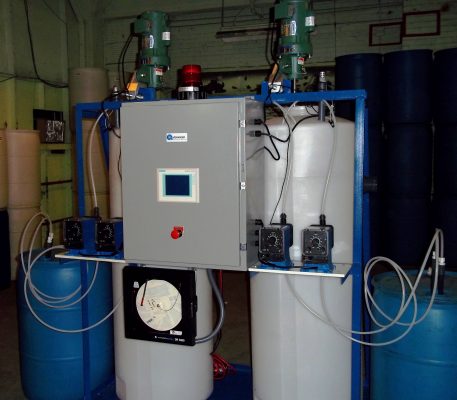The Importance of pH in Wastewater Treatment
Wastewater treatment often consists of removing heavy metals and/or organic compounds from effluent streams. pH adjustment by addition of acidic/basic chemicals is an important part of any wastewater treatment system as it allows dissolved waste to be separated from water during the treatment process.
Water is composed of a positively charged hydrogen ion and a negatively charged hydroxide ion. In acidic (pH<7) water there is a high concentration of positive hydrogen ions while in neutral water, the concentration of hydrogen and hydroxide ions is balanced. Basic (pH>7) water contains an excess of negative hydroxide ions.

pH Adjustment in Wastewater Treatment
By chemically adjusting the pH we can remove heavy metals and other toxic metals from water. In most runoff or wastewater, metal and other contaminants are dissolved and will not settle out. If we raise the pH, the amount of negative hydroxide ions, the positively charged metal ions will form bonds with the negatively charged hydroxide ions. This creates a dense, insoluble, metal particle that can settle out of wastewater given time or be filtered out manually using a filter press.
High and Low pH Water Treatment
At an acidic pH the excess of positive hydrogen and metal ions have nothing to bond with and float around in the water, never settling. At a neutral pH the hydrogen ions are bonded with the hydroxide ions to form water while the metal ions remain. At a basic pH the excess hydroxide ions bond with the metal ions to form metal hydroxides which can be removed through filtering or settling.
Consult Treatment Solutions
Please fill out the form above to get in touch. We look forward to assisting your with your water treatment needs.
Why Control the pH in Your Wastewater?
The pH of water can be used to kill off bacteria in wastewater in addition to the treatment mentioned above. Most organic matter and bacteria we are familiar with and contact daily are best suited to a neutral or slightly basic environment. At an acidic pH the excess hydrogen ions begin to form bonds with and break down the cell, slowing their growth or killing them outright. After a wastewater treatment cycle the pH must be raised back to neutral by use of additional chemicals or it will continue to damage any living cell it contacts.
